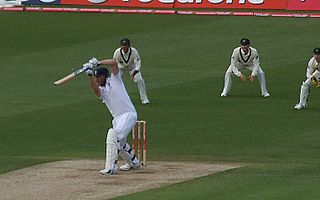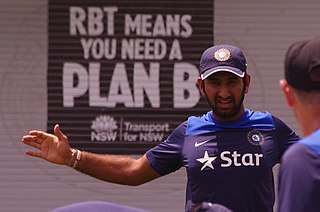Related Research Articles

Vangipurapu Venkata Sai Laxman is a former Indian international cricketer and a former cricket commentator and pundit. A right-hand batsman known for his elegant stroke play, Laxman played as a middle-order batsman in Test cricket. Laxman is currently the Head of Cricket at the National Cricket Academy (NCA), and the head coach of the India Under-19 and India A teams. Laxman was a member of the Indian team that was one of the joint-winners of the 2002 ICC Champions Trophy, which the title was also shared with Sri Lanka.

An all-rounder is a cricketer who regularly performs well at both batting and bowling. Although all bowlers must bat and quite a handful of batsmen do bowl occasionally, most players are skilled in only one of the two disciplines and are considered specialists. Some wicket-keepers have the skills of a specialist batter and have been referred to as all-rounders, but the term wicket-keeper-batter is more commonly applied to them, even if they are substitute wicket keepers who also bowl.
Cricket is a sport that generates a variety of statistics.
Short form cricket is a collective term for several modified forms of the sport of cricket, with playing times significantly shorter than more traditional forms of the game.
Obstructing the field is one of the nine methods of dismissing a batsman in the sport of cricket. Either batsman can be given out if he wilfully attempts to obstruct or distract the fielding side by word or action. It is Law 37 of the Laws of cricket, and is a rare way for a batsman to be dismissed; in the history of cricket, there has been only two instances in Test matches, nine in One Day International (ODI) matches, and six in Twenty20 International matches. There have also been seven instances in Test cricket, and two in ODIs, where a batsman has been dismissed handled the ball, a mode of dismissal now folded into obstructing the field.
Hit wicket is a method of dismissal in the sport of cricket. This method of dismissal is governed by Law 35 of the Laws of Cricket. The striker is out "hit wicket" if, after the bowler has entered his delivery stride and while the ball is in play, his wicket is put down by his bat or his person. The striker may do this whilst preparing to receive or receiving a delivery or in setting off for his first run after playing the delivery. In simple language, if the striking batsman knocks the bails off the stumps or uproots the stumps, while attempting to hit the ball or take off for a run, he is out hit wicket.

Kevin Peter Pietersen is a South African-English cricket commentator, conservationist, and former England international captain. He is a right-handed batsman and occasional off spin bowler who played in all three formats for England between 2005 and 2014, which included a brief tenure as captain. He won the Player of the Series award for his heroics in 2010 ICC World Twenty20 and for helping the England Cricket Team win their maiden ICC trophy.
A Tied Test is a Test cricket match in which the side batting second is bowled out in the fourth innings, with scores level. This is a very rare result; only two ties have occurred in the 2,494 Tests played since 1877. The first was in 1960 and the second in 1986. On both occasions, the aggregate scores of both sides (teams) were equal at the conclusion of play and the side batting last had completed its final innings: 10 batsmen had been dismissed or, from the perspective of the side bowling, 10 wickets had been taken. In other words, after four completed innings, with each innings ending either by a declaration or 10 wickets having fallen, the runs for both teams were exactly the same.
In cricket, a duck is a batsman's dismissal with a score of zero. A batsman being dismissed off their first delivery faced is known as a golden duck.

Cheteshwar Arvind Pujara is an Indian cricketer and is the captain of Sussex County Cricket Club in County Championship. He plays for Saurashtra in Indian domestic cricket. Pujara is known for his disciplined and patient batting style which made him an integral part of the Indian Test team for over a decade. His excellent batting was one of the main reasons of India winning their first-ever test series win in Australia.

Kevin Joseph O'Brien is an Irish former international cricketer who plays for Leinster and Railway Union Cricket Club. On 16 August 2022, he announced his retirement from international cricket.

Shaun Edward Marsh is an Australian cricketer who previously played for the Western Australia cricket team in Australian domestic cricket and has represented Australia in all three formats. Nicknamed SOS, he is a left-handed top-order batsman.

David Andrew Warner is an Australian T20I international cricketer and a former Test vice-captain. A left-handed opening batsman, Warner is the first Australian cricketer in 132 years to be selected for the national team in any format without experience in first-class cricket. He plays for New South Wales and Sydney Thunder in domestic cricket. Warner was a prominent member of the victorious Australian squad of the 2015 Cricket World Cup, the 2021 T20 World Cup, where he was the Player of the Tournament, the 2021–2023 ICC World Test Championship, and the 2023 ICC Cricket World Cup.

Jonathan Marc Bairstow is an English cricketer who plays internationally for England in all formats. In domestic cricket, he represents Yorkshire, and has played in multiple Twenty20 leagues, including for Sunrisers Hyderabad and Punjab Kings in the Indian Premier League.
The Pakistan national cricket team toured Bangladesh from 29 November to 21 December 2011. The tour consisted of one Twenty20 International (T20I), three One Day Internationals (ODIs) and two Test matches, all of which were won by Pakistan.

Frank Dimuth Madushanka Karunaratne, popularly known as Dimuth Karunaratne, is a professional Sri Lankan cricketer and former captain of the Sri Lanka Test and ODI teams. Considered as one of the best Test openers in the world, he has included 3 times in the ICC Test Cricket Team of the Year. He is the opening batter for Sri Lanka in Test cricket and ODIs. He plays first-class cricket for the Sinhalese Sports Club.
In cricket, a batsman may retire from an innings at any time when the ball is dead; they must then be replaced by a teammate who has not been dismissed. The most common reason for retirement is if the batsman becomes injured or unwell, in which case they can resume their innings.
References
- ↑ Lynch, Steven (9 December 2008). "One-day ducks, and carrying the bat". ESPNcricinfo. Archived from the original on 27 September 2011. Retrieved 19 July 2009.
- ↑ Rundell, Michael (2006). Wisden Dictionary of Cricket. A & C Black Publishers Ltd. ISBN 0-7136-7915-8.
- ↑ "Scorecard: South Africa vs England, 2nd Test, March 1889". CricketArchive. Archived from the original on 18 January 2007. Retrieved 19 July 2009.
- ↑ "Test match batting records: Carrying bat through a completed innings". ESPNcricinfo. Archived from the original on 19 February 2015. Retrieved 8 June 2013.
- ↑ "Records - One-Day Internationals - Batting records - Carrying bat through a completed innings". ESPNcricinfo. Archived from the original on 1 April 2019. Retrieved 7 September 2023.
- ↑ "Sri Lanka thrash Windies in semis". BBC Sport. 19 June 2009. Retrieved 8 June 2013.
- ↑ Lynch, Steven (9 September 2008). "Carrying the bat, and the 11-ball over". ESPNcricinfo. Archived from the original on 3 November 2012. Retrieved 19 July 2009.
- ↑ "Samit Gohel's 359* shatters 117-year record". ESPN Cricinfo. 27 December 2016. Archived from the original on 28 December 2016. Retrieved 27 December 2016.
- ↑ "Scorecard: Gloucestershire v Middlesex, 1909" . CricketArchive. Archived from the original on 16 October 2014. Retrieved 10 October 2014.